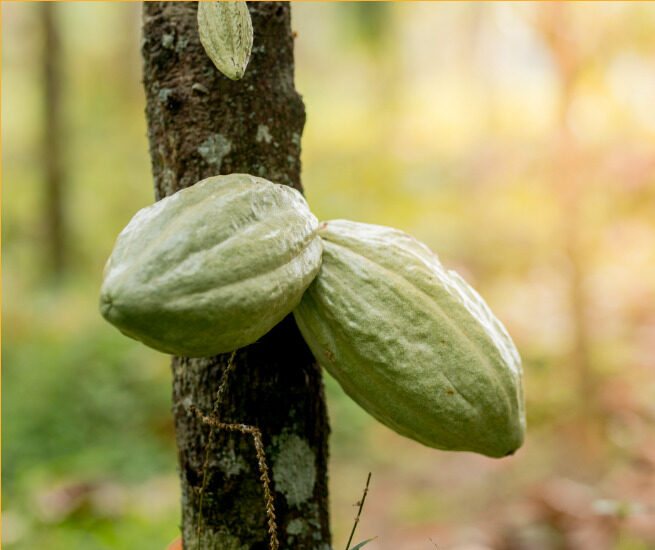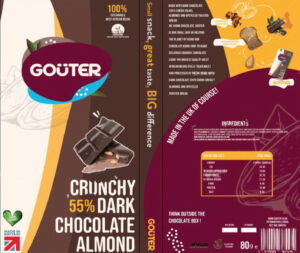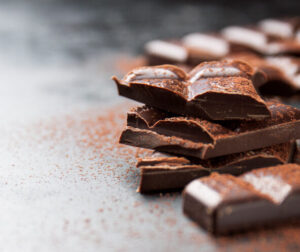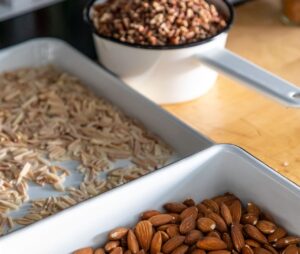How is Chocolate Made?
From tree to beans to delicious liquid chocolate, here’s everything you need to know.
We believe that the more you know about your food and where it comes from, the more you will appreciate the result. Well, just call us Willy Wonka because we’re here to tell you how chocolate goes from trees to roasted beans, and ultimately ends up as a delicious chocolate bar in your local shop. Roald Dahl may have had us believe that there were some strange things going on behind the scenes, but we’re here to set the record straight!
Let’s be honest, we are all chocoholics at heart, and you can’t have chocolate without the humble cocoa bean, so let’s learn about how these simple beans make such an amazing, sweet treat. Here’s everything you need to know about how our team makes our delicious chocolate for our GOÜTER clusters.
Where Does Chocolate Come From?
Cocoa, the primary ingredient in chocolate, comes from the cocoa tree. The cocoa beans come from cocoa pods, which grow directly on the tree bark. Cocoa tree plantations are all around the equator as this climate provides the ideal conditions for the trees to grow. The majority (70%) of cocoa farms are in West Africa (mainly the Ivory Coast, Ghana and Nigeria), as the cocoa tree thrives in scorching conditions. The trees take four years to mature and bear fruit. Once they’re ready, the harvest begins. The trees are harvested twice a year, with the first batch in September and a smaller harvest in March.
Harvesting Cocoa Beans
- The cocoa pods are harvested and manually opened to reveal the beans (the fruit of the trees). Each pod will contain between 30-45 beans. The farmers know the beans are ready when the skin of pods can be scraped and won’t reveal a green underlayer.
- The beans and the pulp are fermented in a wooden crate for five to ten days. The juice from the fermenting beans will drain away during this time, which is known as ‘sweating’ the beans. This allows the flavour to develop. You might wonder if the farmers mind the smell of fermenting beans, but they give off a sweet vinegar aroma.
- After the beans have been removed from the pods, the pods can be put back onto the ground surrounding the trees to compost and give nutrients back to the plants.
- The beans are dried naturally in the sun, sometimes on large banana leaves. This process takes five days, and the cocoa flavour intensifies. Depending on the farm, wood fires might also be used to speed up the drying process, leading to a woody, smoked flavour in the final product.
- Beans are washed in water and redried. Then they can be stored and shipped off, ready to be made into chocolate!
From Beans To Chocolate:
- Cleaning – the beans are thoroughly cleaned to remove debris and a few jungle critters or even a scorpion or two!
- Roasting – the clean beans are then roasted (similar to coffee beans). This can create a whopping 600 different aromas from the beans. This is generally where the most flavour comes from and where the complexity of the taste is built. Roasting also sterilises the cocoa bean, which is essential after the plantations have fermented them. Fermenting creates thousands of bacteria, fungi and moulds, so roasting is vital to keeping the result free from any nasties.
- Winnowing – the cocoa nibs (tiny pieces of the beans) are then broken from their shells and removed using a fine sieve. Some factories prefer to roast before separating the nibs, but either way works.
- Grinding – the cocoa paste is made by grinding the beans in 50° heat. The paste
is also known as ‘cocoa mass’ or ‘cocoa liquor’ and is made of equal portions of cocoa butter and cocoa solids. If need be, the butter and solids can be separated for different uses by pressing the paste. - Conching – the final step is mixing the liquor with sugar to create liquid chocolate! The amount of sugar will depend on the % of cocoa in the final bar. For example, a 70% chocolate bar will be roughly 70% cacao and 30% sugar. Although it’s not quite over yet, this mixing process can take up to three days to achieve a smooth result and signature taste.
British Vs. European Chocolate
Our GOÜTER clusters are made using the finest quality British chocolate. For over 100 years, the chocolate recipe used in Ireland and the UK has been different to the rest of Europe, resulting in British chocolate having a distinctive rich and smooth taste. Our combination of British know-how and local ingredients creates a superior chocolate to its
Swiss or Belgian counterparts.
Swiss chocolate can be higher in fat and milk, and the milky flavour can sometimes give it a sickly-sweet aftertaste. Belgian chocolate has the opposite issue, using a high cocoa content which can lead to bitterness. British chocolate sits in the sweet spot between enough cocoa and not too much milk, creating harmonious chocolate bars with authentic cocoa flavours, while balancing the bitterness. British chocolate also has beautiful caramel notes from the natural ingredients.
Our premium artisan GOÜTER chocolate is here to put British chocolate back on the map. We use high cocoa content and enough sugar to create chocolate that produces a satisfying snap when broken. We produce our British chocolate in small batches to ensure quality and taste in every bite.
Ready to Try Some?
After reading so much about the process of going from bean to chocolate bar, you’re probably ready to dig in (if you haven’t already taken a break from reading this to order some!). Now you know all about what differentiates the types of chocolate and how chocolate is made!




